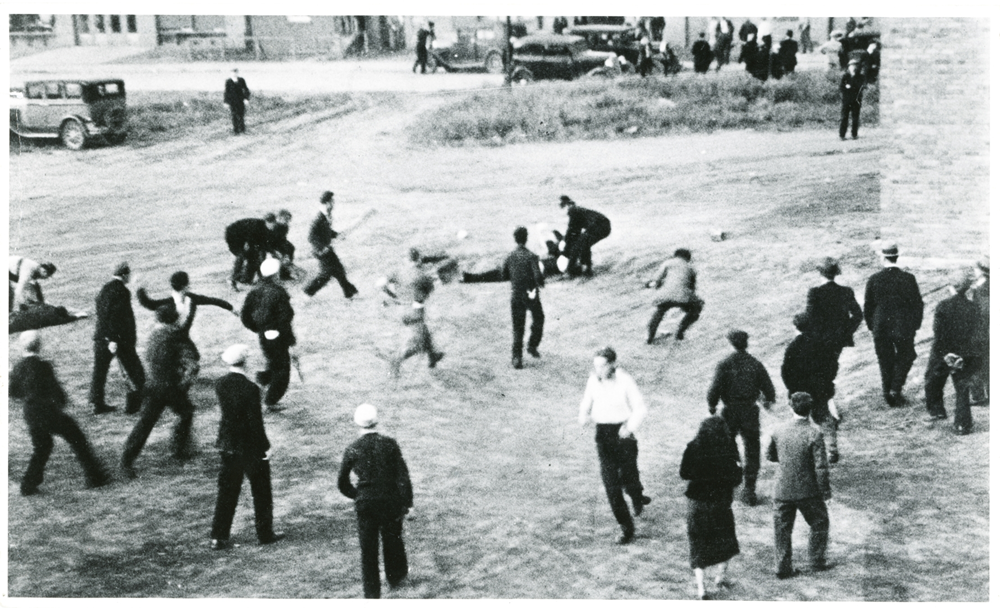Our City: The Regina Riots
Regina Riot, July 1, 1935. Regina Archives.
In April of 1935, strikes began in British Columbia, protesting the terrible conditions of the Unemployment Relief Camps of the Great Depression.
The camps were unhelpful to this already disadvantaged group; work weeks were 44 hours long but the workers were paid an almost useless wage of $0.20 per day (equivalent to about $4.30 today). Local governments wanted no involvement in the strikers, the federal government wouldn’t provide any improved work and wage programs, the Vancouver protests yielded no results, and the men had no opportunity of securing meaningful work. The protest had to come to Ottawa.
On June 3rd, over 1,000 strikers led by Workers’ Unity League (WUL) officer Arthur Evans decided to raise their concerns directly to the federal government by traveling to Ottawa in the On to Ottawa Trek. The group moved via freight trains, commandeering them peacefully. Police and the government assumed the men would give up shortly, so no efforts were made to prevent them. As they traveled, the strikers stopped at various cities including Calgary, Swift Current, and Moose Jaw, increasing their numbers with each stop and reaching 2,000 by the time they reached Regina. Upon arriving in Regina on June 14th, the protestors were stopped and refused further use of the trains.
Premier James Gardiner had concerns about stopping the strike in Regina, believing it would result in a riot. In the following days, 8 strikers met with Prime Minister R.B. Bennett. In the meantime, the remaining protestors were provided with food and shelter by Regina citizens and the SK government. Upon returning from meeting with Bennett, they chose to disband the Trek leading to a final rally at Regina’s Market Square on July 1st.
Here, Bennett chose to have the strike leaders arrested. The peaceful rally held to strategize and get assistance from Regina citizens quickly turned into one of Canada's worst Depression-era riots. The RCMP moved in to arrest Arthur Evans and other organizers, initiating the conflict now known as the Regina Riot. Mounties arrived in large vans or on horses armed with bats, guns, teargas, and riot gear, and local police waited on the sidelines. Many attendees were simply Regina townsfolk curious about what was happening, but they too were caught in the crossfire when the strikers retaliated.
Strikers fought back with rocks and clubs and barricades for hours while police emptied their guns into the crowd. There were major casualties on both sides, the strikers putting up a good fight despite their disadvantage in gear and organization. By the next morning, two people had been killed, one being an officer, and hundreds were injured. Over 100 people were sent to the hospital, 40 of which were police, and approximately 130 strikers were arrested. The city suffered thousands of dollars worth of damages.
In the following days, the Saskatchewan government assisted with travel for the strikers, sending many back to Vancouver by train. The Trek was over and the men were either sent to jail or had to return to the camps. Later, the Regina Riot Inquiry Commission decided the police did nothing wrong. A peaceful strike protesting the conditions of the camps became an outcry against the government's lack of support and poor handling of the people’s needs during the Depression. The site of the riot was declared a National Historic Site in 1997.
Trekkers at Regina Exhibition Grounds, Regina Riot, 1935, Regina Archives.
Sources:
https://www.pc.gc.ca/apps/dfhd/page_nhs_eng.aspx?id=1781
https://www.canadashistory.ca/explore/peace-conflict/the-regina-riot
https://www.cbc.ca/history/EPISCONTENTSE1EP13CH3PA4LE.html
https://esask.uregina.ca/entry/on-to-ottawa_trek_and_the_regina_riot.jsp
https://www.thecanadianencyclopedia.ca/en/article/on-to-ottawa-trek


